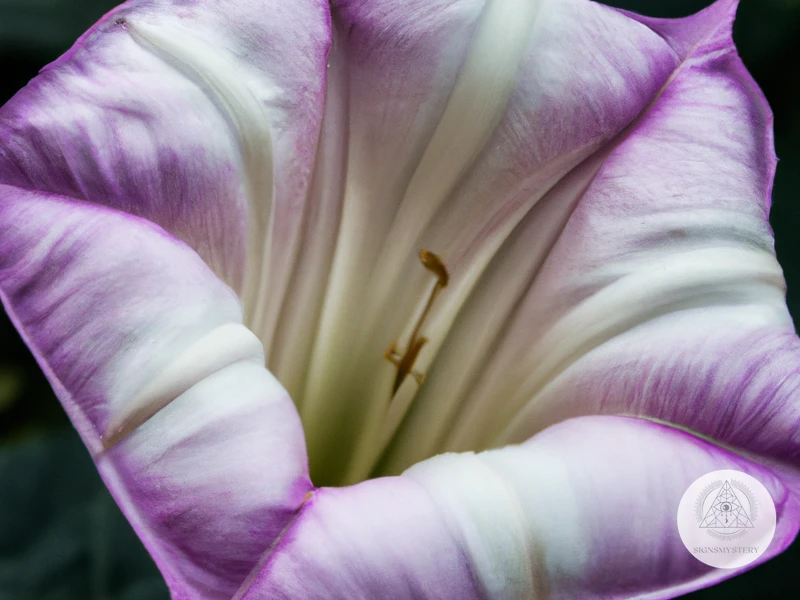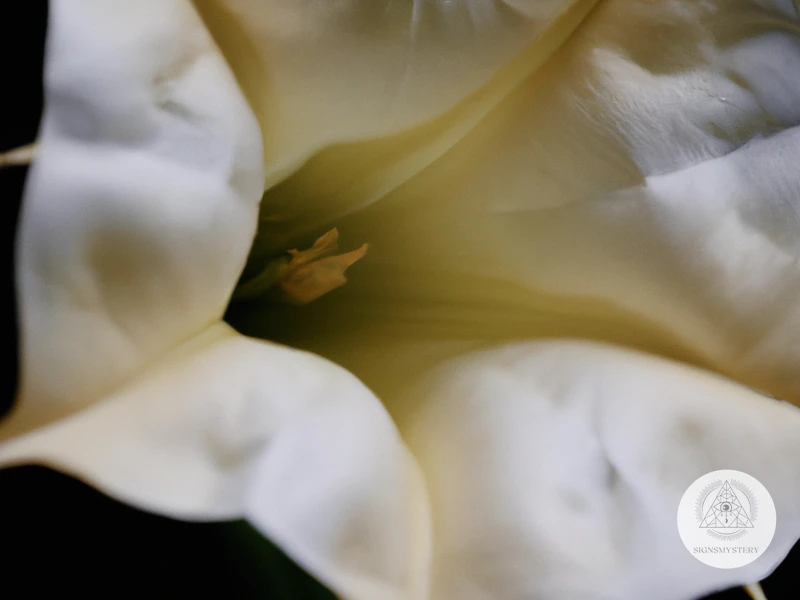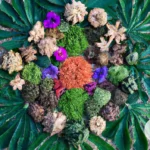Datura is a fascinating plant with a rich history and a dark reputation. Its properties have been known for centuries, and it has been used for both medicinal purposes and spiritual and religious practices. However, its lethal effects on humans have also been well-documented. Despite its dangers, datura continues to fascinate people and has even been used recreationally and as a tool for self-discovery. In this article, we will delve into the fascinating history of Datura, from its use in shamanism to its current medicinal and recreational uses, as well as provide information on how to identify and use it safely.
What is Datura?

Datura, also known as jimsonweed, is a plant species belonging to the nightshade family. Its name is derived from the Hindi word “dhatura,” which means “thorn apple.” Datura’s properties and effects are both fascinating and dangerous. The plant can induce hallucinations, delirium, and, in some cases, death. In shamanism, Datura has a long history of use for its psychoactive properties. Datura’s cultural significance is evidenced in art, literature, and religion around the world. Datura is still used medicinally today but is also a source of recreational abuse. It’s important to identify and use Datura safely to avoid the lethal consequences. If you’re interested in learning more about plant medicines in shamanism, check out our article on top 10 plant medicines in shamanism.
Properties and Effects
Datura, also known as Jimsonweed, is a highly medicinal and psychoactive plant with potent properties and effects. The plant is characterized by its large, trumpet-shaped flowers and thorny fruits. Datura has been traditionally used for its healing properties, and its effects have been compared to those of other psychoactive plants like peyote and ayahuasca.
Properties:
– Datura contains several alkaloids, including atropine, scopolamine, and hyoscyamine, which are responsible for its psychoactive effects.
– The plant also contains flavonoids, tannins, and other compounds that give it medicinal properties.
– Datura is considered a powerful antispasmodic, analgesic, anti-inflammatory, and sedative.
– The plant has been used to treat conditions such as asthma, cough, epilepsy, and rheumatism.
Effects:
– The effects of Datura can be highly unpredictable and vary depending on the doses and individual tolerance.
– Some common effects of Datura include hallucinations, delirium, confusion, disorientation, and memory impairment.
– Datura can cause physical effects such as pupillary dilation, dry mouth, blurred vision, and urinary retention.
– In high doses, Datura can cause seizures, coma, and even death due to respiratory failure.
– Datura can also cause long-term effects such as psychosis, memory loss, and cognitive impairment.
Caution:
– It is essential to approach Datura with caution, as it can be extremely toxic and dangerous if ingested in high doses.
– Individuals who are pregnant, nursing, or have a history of mental illness, heart disease, or seizures should avoid the use of Datura.
– Datura should never be combined with other psychoactive substances or alcohol, as it can increase the risk of adverse reactions and even death.
Internal link: For more information on other types of shamanic plant medicines, check out our Ayahuasca guide.
Historical use in shamanism
Historical use in shamanism:
Datura has been used in various shamanic practices around the world for centuries. Shamans would prepare a potion made from datura and administer it to their patients to induce visions that were believed to help them find answers to their problems. The use of datura in shamanism is deeply rooted in South American culture and is considered to be a sacred plant in many indigenous communities.
In some shamanic practices, datura is also used in combination with other plants to create a powerful concoction. For example, in Ayahuasca rituals, datura is often added to the brew to intensify the experience. This mixture, also known as “Huarmi Huasi,” is believed to allow communication with spirits and ancestors.
Datura is considered to be a plant of transformation and rebirth in shamanic practices. It is believed to have the power to connect the physical world with the spiritual realm, allowing shamans to delve deeper into their spirituality.
However, it is important to note that using datura in shamanic practices requires extensive knowledge and experience. The plant is highly toxic and can be fatal if not prepared or used correctly.
Fun Fact: In some cultures, datura is known as the “devil’s trumpet” due to its powerful and unpredictable effects on the mind and body during shamanic rituals.
Datura has played a significant role in shamanism throughout history and continues to be used by some indigenous communities today. If you are interested in learning more about other shamanic plant medicines, check out our articles on Kambo, Mapacho, and Peyote.
The Dark Side of Datura
Datura, also known as “devil’s trumpet” or “thorn apple”, can be a deadly poison if taken improperly. This plant contains potent hallucinogens such as scopolamine, hyoscyamine, and atropine, which can cause euphoria and delirium in small doses, but can lead to seizures, comas, and even death in larger doses. The lethal effects of Datura are well-documented throughout history, from its use in murder cases to accidental poisonings. The chemical compounds in Datura also make it difficult to dose accurately, leading to unpredictable and dangerous effects. It is important to note that Datura should only be used under the guidance of an experienced practitioner, if at all. Those seeking alternative shamanic plant medicines may consider options such as San Pedro cactus, psilocybin mushrooms, coca leaves, or yopo.
Lethal effects on humans
While Datura has been used for centuries for medicinal and spiritual purposes, it can also have deadly consequences when not used properly. The plant contains toxic tropane alkaloids such as scopolamine, hyoscyamine, and atropine, which can cause severe harm to the human body.
Ingesting large amounts of Datura can result in intense hallucinations and delirium, making it difficult for individuals to distinguish reality from illusion. It can also lead to confusion, memory loss, and disorientation, which can be dangerous when operating machinery or driving a vehicle.
Physical effects of Datura include dilation of the pupils, sensitivity to light, dry mouth, impaired speech, rapid heartbeat, and in severe cases, respiratory failure and death.
Children and pets are especially vulnerable to the lethal effects of Datura due to their smaller body mass. Even a small amount of the plant can be enough to cause significant harm or death in these individuals.
It is also important to note that Datura can have unpredictable effects on each individual, making it difficult to determine a safe dosage or usage. Consulting with a medical professional or trained herbalist before using Datura is imperative to minimize the risk of lethal consequences.
While Datura can have potential benefits for medicinal and spiritual purposes, it carries a significant risk of serious harm or even death if used improperly. It is important to exercise caution and seek professional guidance before using this plant.
Chemical compounds in Datura
Datura contains several active chemical compounds that are responsible for its effects on the human body. The following are some of the major chemical compounds found in Datura:
| Compound Name | Effect |
|---|---|
| Scopolamine | Scopolamine is a powerful hallucinogen that is believed to be responsible for most of the hallucinogenic effects of Datura. It is also used as a sedative and for the treatment of motion sickness. |
| Hyoscyamine | Hyoscyamine is another hallucinogenic compound found in Datura. It is also a potent antispasmodic and is used for the treatment of irritable bowel syndrome and other intestinal disorders. |
| Atropine | Atropine is a toxic alkaloid found in Datura. It acts as an anticholinergic and can cause respiratory distress and death if consumed in high doses. |
| Scopoletin | Scopoletin is a coumarin that is found in Datura. It has anti-inflammatory properties and is used for the treatment of arthritis and other inflammatory disorders. |
It is important to note that the chemical compounds found in Datura can be both beneficial and harmful, depending on their dosage and how they are used. Scopolamine and hyoscyamine are used medicinally for the treatment of various ailments, while atropine is a potent toxin that can be lethal if consumed in excessive amounts. Caution must be exercised when using Datura for any purpose.
Cultural Significance of Datura

Datura is a plant that has had a significant impact on human culture throughout history. It has been used in art and literature, often symbolizing madness and magic. In religion and spirituality, Datura is sometimes used as a sacrament during rituals, with the belief that it can induce visions and connect the user to the spiritual realm. However, the use of Datura in these contexts can also be dangerous and potentially lethal. Despite its toxic nature, some cultures still find value in Datura as a medicinal plant, using it to treat various ailments. Datura’s cultural significance reveals the complex relationship between humans and the natural world, where a plant can be both revered and feared.
Datura in art and literature
Datura has a rich cultural and historical significance, including its notable place in art and literature. The plant’s beauty and mystical properties inspired numerous artists and writers throughout history. In fact, “Datura” is the title of a famous novel by the French author Jean-Marie Gustave Le Clézio, which explores themes of madness, mysticism, and cultural displacement.
The plant was often depicted in art, particularly during the Art Nouveau period. The artist Alphonse Mucha included the Datura flower in his graceful and intricate designs. The plant also found its way into literature as a symbol of poison, temptation, and altered states of consciousness. For instance, in Shakespeare’s “Hamlet,” the character Ophelia speaks of the “deadly nightshade” (a common name for Datura) and “the weeping Datura” as she descends into madness.
Similarly, the author Vladimir Nabokov used the plant in his novel “Lolita” as a symbol of the protagonist’s destructive obsession. The plant’s toxic properties, combined with its alluring appearance, make it a fitting metaphor for the dangers of desire and obsession.
Datura’s unique properties have made it a compelling subject in art and literature. Its associations with madness, mysticism, and danger continue to inspire artists and writers today.
Datura in religion and spirituality
Datura has been an important part of various religious and spiritual practices across the world for centuries. Its hallucinogenic properties have been used to induce altered states of consciousness and provide access to divine realms. Here are some examples of the use of Datura in religion and spirituality:
| Religion/Spirituality | Country/Area | Use of Datura |
|---|---|---|
| Native American Religion | North and South America | Datura is used by some tribes for shamanic purposes, including divination, vision quests, and healing ceremonies. However, its use is considered dangerous and requires great caution. |
| Hinduism | India | Datura is considered a sacred plant in Hinduism and is associated with Lord Shiva. It is used in some rituals and ceremonies, such as the worship of the goddess Kali. |
| Witchcraft and Magic | Europe and the Americas | Datura has been used in various spells and rituals related to love, power, and transformation. However, its use is highly dangerous and is not recommended. |
It should be noted that the use of Datura in religious and spiritual practices is often associated with great caution and strict guidelines. Mishandling of the plant can result in severe poisoning and even death. It is important to approach its use with great respect and knowledge of the risks involved.
The use of Datura in religion and spirituality highlights its significance as a powerful plant ally with the ability to induce altered states of consciousness and provide access to spiritual realms. However, its use should always be approached with caution and under the guidance of experienced practitioners.
Modern Uses of Datura
Datura, despite being known for its harmful effects, has been used for several medicinal purposes. It contains potent compounds like scopolamine and hyoscyamine that have been utilized to treat motion sickness, asthma, and Parkinson’s disease. However, the use of Datura for medicinal purposes is highly risky and should only be done under expert supervision. Some individuals abuse Datura for its hallucinogenic properties. The recreational use of Datura can cause severe intoxication, delirium, and even death. It is vital to understand that the modern use of Datura is not recommended unless under controlled research conditions or by a licensed medical professional.
Medicinal uses
Datura has a long history
Subscribe to Our Newsletter
Sign up to receive the latest news and updates.
| Condition Treated | Method of Administration | Traditional Medicinal Use |
|---|---|---|
| Respiratory disorders | Inhalation | Datura was traditionally used to ease the symptoms of asthma, coughs, and colds. The leaves were burned and the smoke inhaled to help alleviate congestion and open up the airways. |
| Muscle spasms and pain | Topical application or ingestion | The leaves and seeds of Datura were applied topically to relieve muscle spasms and pain. The plant was also brewed into a tea and ingested to ease menstrual cramps and other types of pain. |
| Psychiatric disorders | Ingestion | Datura was sometimes used as a treatment for psychiatric disorders such as schizophrenia and depression. However, its use in this context was highly dangerous and could easily lead to lethal overdose. |
It’s important to note that the use of Datura for these conditions is not recommended due to its high level of toxicity. The plant is difficult to dose properly and can easily cause harmful side effects or even death. Additionally, there are many modern medications available that are both safer and more effective for treating these conditions.
In Summary: Datura has been used for a variety of medicinal purposes throughout history, but its toxicity makes it unsafe for modern medical use. While some traditional remedies involving Datura may have been effective, there are safer and more reliable modern treatments available.
Recreational use and abuse
While Datura has been used for spiritual and medicinal purposes throughout history, its toxicity and unpredictable effects also make it a popular choice for recreational drug users seeking a unique hallucinogenic experience. Unfortunately, this has led to a significant increase in the number of cases of Datura poisoning in recent years.
The psychoactive effects of Datura vary depending on the part of the plant, the method of ingestion, and the individual’s tolerance. The most common method of consumption is smoking the leaves or inhaling the dried powdered leaves. However, this can be extremely dangerous because the concentration of the active compounds in the leaves can vary widely and lead to unpredictable effects.
The recreational use of Datura can cause extreme hallucinations, delirium, and memory loss. It can also lead to paranoia, violent behavior, and even coma or death. Unlike other hallucinogenic drugs like LSD or psilocybin, which have scientifically studied effects and dosages, there is no safe way to use Datura recreationally.
Abuse of Datura is also a significant issue, with many individuals using the drug as a form of self-harm or suicide. Due to the plant’s potent effects, it is often used as a means of escape from reality or to induce a suicidal state. Individuals struggling with addiction or mental health issues should seek professional help rather than turning to Datura as a coping mechanism.
In conclusion, Datura should never be used recreationally due to its unpredictable effects and significant potential for harm. Seek professional help if struggling with addiction or mental health issues rather than turning to dangerous substances like Datura.
How to Identify and Use Datura Safely
Identifying and using Datura safely requires caution and attention to detail. Here are some tips to help you stay safe:
Identifying Datura
Datura plants are known for their large trumpet-shaped flowers and spiny seed capsules. They can reach up to 5 feet in height and have a distinctive odor. There are several types of datura, including Datura stramonium, Datura inoxia, and Datura metel.
To identify Datura, look for the following characteristics:
- Flowers: Datura flowers are large, trumpet-shaped and can be white, yellow, pink, or purple. They have prominent pistils and stamens and a distinctive fragrance.
- Leaves: Datura leaves are large, oval with a pointed tip, and have irregularly toothed margins. They can be up to 8 inches long and 6 inches wide and are generally arranged alternately along the stem.
- Seeds: Datura seeds are enclosed in a spiny capsule that splits open at maturity. The seeds are black or brown and can be up to 1/2 inch in diameter.
- Height: Datura plants can reach up to 5 feet in height.
- Scent: Datura plants have a distinctive, sweet-smelling fragrance.
Using Datura Safely
While Datura has historically been used for medicinal, spiritual, and shamanic purposes, it is important to approach the plant with caution. Datura can be toxic and even deadly if ingested improperly. Here are some guidelines for using Datura safely:
- Do not ingest the plant: Datura can be toxic when ingested, and even a small amount can cause serious side effects. If you want to use Datura for spiritual or shamanic purposes, consider using it in a non-ingestible form such as through smoke or incense.
- Wear protective clothing: When handling Datura, wear gloves and protective clothing. The sap from the plant can cause skin irritation, and the seeds can be toxic if ingested or inhaled.
- Keep away from children and pets: Datura should be kept out of reach of children and pets, as even a small amount can cause serious harm.
- Dispose of plant carefully: If you decide to remove Datura plants from your garden, make sure to dispose of them carefully. Do not compost or burn the plant, as the toxic chemicals can be released into the air.
- Consult with a healthcare professional: If you are considering using Datura for medicinal purposes, it is important to consult with a healthcare professional first. Datura can interact with other medications and can cause serious side effects if used improperly.
By following these guidelines, you can safely identify and use Datura for its various purposes. However, remember that Datura is a powerful and potentially dangerous plant. Proceed with caution and always prioritize your safety.
Conclusion
In conclusion, the history of datura is as captivating as it is dangerous. This plant has been used for centuries and has been believed to possess mystical and spiritual properties by various cultures around the world. However, its lethal effects on humans cannot be ignored. It is essential to approach the plant with caution and respect.
While datura has some interesting medicinal uses, the risks associated with using it outweigh the potential benefits. Recreational use of datura is highly discouraged due to its adverse effects on human health, including potential death. Additionally, the plant’s unpredictable and variable concentration of compounds makes it impossible to determine safe usage levels.
In terms of identifying and using datura safely, it’s best to avoid it altogether. If one must use datura, the utmost care must be taken, and it is important to consult experts in the field who have experience working with the plant.
Overall, while datura has fascinating and mystical properties, its lethal effects make it a dangerous plant to use. It is essential to take all precautions necessary to ensure the safe use of datura.
Frequently Asked Questions
What are the active compounds in Datura?
The active compounds in Datura are tropane alkaloids, including atropine, hyoscyamine, and scopolamine.
Can Datura be used as medicine?
Yes, Datura has a long history of being used in traditional medicine for a variety of ailments, such as asthma, fever, and pain.
Is Datura legal?
Datura is legal to grow in many parts of the world, but its use and possession may be restricted due to its potential for abuse and toxic effects.
Can Datura be used for recreational purposes?
Yes, Datura has been used recreationally for its hallucinogenic effects, although this is highly discouraged due to the risk of overdose and adverse reactions.
How can Datura be identified in the wild?
Datura plants can be identified by their large, trumpet-shaped flowers and distinctive seed pods covered in prickly spines.
What are the symptoms of Datura intoxication?
Symptoms of Datura intoxication can include confusion, hallucinations, fever, rapid heartbeat, and dilated pupils.
Is it safe to consume Datura?
No, consuming Datura is not safe due to the potential for overdose and lethal effects on the body.
Can Datura be used as a natural pesticide?
Yes, Datura contains compounds that can repel or kill insect pests in gardens and crops.
What is the cultural significance of Datura?
Datura has a rich cultural history, being used in artwork, literature, and spiritual practices around the world.
How can Datura be used safely?
It is highly recommended to not use Datura recreationally or without professional medical guidance. If using Datura for medicinal purposes, it should be done under the supervision of a trained healthcare provider with proper dosing and monitoring.










